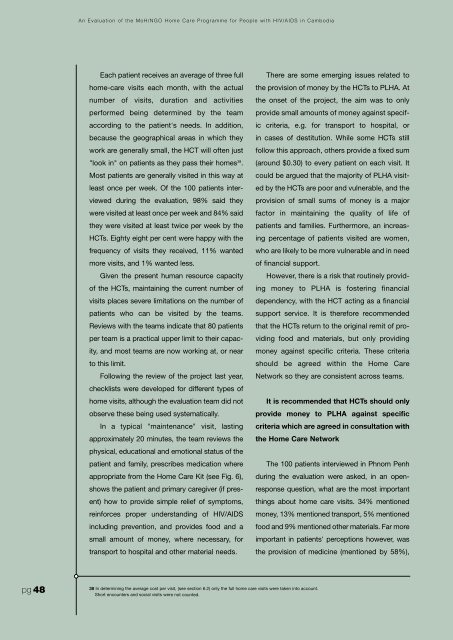PDF File - hivpolicy.org
PDF File - hivpolicy.org
PDF File - hivpolicy.org
- No tags were found...
You also want an ePaper? Increase the reach of your titles
YUMPU automatically turns print PDFs into web optimized ePapers that Google loves.
An Evaluation of the MoH/NGO Home Care Programme for People with HIV/AIDS in CambodiaEach patient receives an average of three fullhome-care visits each month, with the actualnumber of visits, duration and activitiesperformed being determined by the teamaccording to the patient's needs. In addition,because the geographical areas in which theywork are generally small, the HCT will often just"look in" on patients as they pass their homes 38 .Most patients are generally visited in this way atleast once per week. Of the 100 patients interviewedduring the evaluation, 98% said theywere visited at least once per week and 84% saidthey were visited at least twice per week by theHCTs. Eighty eight per cent were happy with thefrequency of visits they received, 11% wantedmore visits, and 1% wanted less.Given the present human resource capacityof the HCTs, maintaining the current number ofvisits places severe limitations on the number ofpatients who can be visited by the teams.Reviews with the teams indicate that 80 patientsper team is a practical upper limit to their capacity,and most teams are now working at, or nearto this limit.Following the review of the project last year,checklists were developed for different types ofhome visits, although the evaluation team did notobserve these being used systematically.In a typical "maintenance" visit, lastingapproximately 20 minutes, the team reviews thephysical, educational and emotional status of thepatient and family, prescribes medication whereappropriate from the Home Care Kit (see Fig. 6),shows the patient and primary caregiver (if present)how to provide simple relief of symptoms,reinforces proper understanding of HIV/AIDSincluding prevention, and provides food and asmall amount of money, where necessary, fortransport to hospital and other material needs.There are some emerging issues related tothe provision of money by the HCTs to PLHA. Atthe onset of the project, the aim was to onlyprovide small amounts of money against specificcriteria, e.g. for transport to hospital, orin cases of destitution. While some HCTs stillfollow this approach, others provide a fixed sum(around $0.30) to every patient on each visit. Itcould be argued that the majority of PLHA visitedby the HCTs are poor and vulnerable, and theprovision of small sums of money is a majorfactor in maintaining the quality of life ofpatients and families. Furthermore, an increasingpercentage of patients visited are women,who are likely to be more vulnerable and in needof financial support.However, there is a risk that routinely providingmoney to PLHA is fostering financialdependency, with the HCT acting as a financialsupport service. It is therefore recommendedthat the HCTs return to the original remit of providingfood and materials, but only providingmoney against specific criteria. These criteriashould be agreed within the Home CareNetwork so they are consistent across teams.It is recommended that HCTs should onlyprovide money to PLHA against specificcriteria which are agreed in consultation withthe Home Care NetworkThe 100 patients interviewed in Phnom Penhduring the evaluation were asked, in an openresponsequestion, what are the most importantthings about home care visits. 34% mentionedmoney, 13% mentioned transport, 5% mentionedfood and 9% mentioned other materials. Far moreimportant in patients' perceptions however, wasthe provision of medicine (mentioned by 58%),pg 4838 In determining the average cost per visit, (see section 6.2) only the full home care visits were taken into account.Short encounters and social visits were not counted.
















